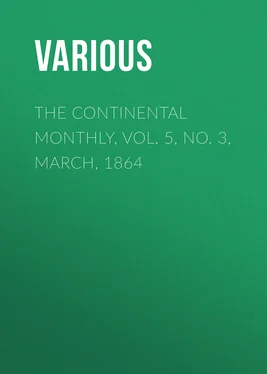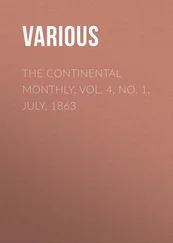Various - The Continental Monthly, Vol. 5, No. 3, March, 1864
Здесь есть возможность читать онлайн «Various - The Continental Monthly, Vol. 5, No. 3, March, 1864» — ознакомительный отрывок электронной книги совершенно бесплатно, а после прочтения отрывка купить полную версию. В некоторых случаях можно слушать аудио, скачать через торрент в формате fb2 и присутствует краткое содержание. Жанр: foreign_antique, periodic, Языкознание, Политика, foreign_edu, на английском языке. Описание произведения, (предисловие) а так же отзывы посетителей доступны на портале библиотеки ЛибКат.
- Название:The Continental Monthly, Vol. 5, No. 3, March, 1864
- Автор:
- Жанр:
- Год:неизвестен
- ISBN:нет данных
- Рейтинг книги:3 / 5. Голосов: 1
-
Избранное:Добавить в избранное
- Отзывы:
-
Ваша оценка:
- 60
- 1
- 2
- 3
- 4
- 5
The Continental Monthly, Vol. 5, No. 3, March, 1864: краткое содержание, описание и аннотация
Предлагаем к чтению аннотацию, описание, краткое содержание или предисловие (зависит от того, что написал сам автор книги «The Continental Monthly, Vol. 5, No. 3, March, 1864»). Если вы не нашли необходимую информацию о книге — напишите в комментариях, мы постараемся отыскать её.
The Continental Monthly, Vol. 5, No. 3, March, 1864 — читать онлайн ознакомительный отрывок
Ниже представлен текст книги, разбитый по страницам. Система сохранения места последней прочитанной страницы, позволяет с удобством читать онлайн бесплатно книгу «The Continental Monthly, Vol. 5, No. 3, March, 1864», без необходимости каждый раз заново искать на чём Вы остановились. Поставьте закладку, и сможете в любой момент перейти на страницу, на которой закончили чтение.
Интервал:
Закладка:
The isothermals of the great Humboldt (differing so widely from parallels), which trace the lines of temperature on the earth's surface, prove, as to heat, the climate of the South (running a line from Charleston to Vicksburg) to be substantially the same as that of Greece and Italy-each, in its turn, the mistress of the world.
The Census of 1860 exhibits our increase of population from 1790 to 1860 at 35.59 per cent., and of our wealth 126.45. Now, if we would increase the wealth of the country only one tenth in the next ten years, by the gradual disappearance of slavery (far below the results of the Census), then our wealth being now $16,159,616,068, the effect of such increase would be to make our wealth in 1870, instead of $36,593,450,585, more than sixteen hundred millions greater, and in 1880, instead of $82,865,868,849, over three billions six hundred millions, or more than three times our present debt.
Before the close of this letter, it will be shown that the difference, per capita , of the annual products of Massachusetts and Maryland exceeds $150. As to the other Southern States, the excess is much greater. Now, if the annual products of the South were increased $150 each per capita (still far below Massachusetts) by the exclusion of slavery, then multiplying the total population of the South, 12,229,727, by 150, the result would be an addition to the annual value of the products of the South of $1,834,456,050, and in the decade, $18,344,580,500. This change would not be immediate, but there can be no doubt that with the vastly greater natural advantages of the South, the superiority of free to slave labor, the immense immigration, especially from Europe to the South, aided by the Homestead Bill, and the conversion of large plantations into small farms, an addition of at least one billion of dollars would be made in a decade, by the exclusion of slavery, to the value of the products of the South.
Having considered the relative progress in population of Massachusetts and Maryland, I will now examine their advance in wealth.
By Tables 33 and 36, Census of 1860, the value of the products of Massachusetts that year was $287,000,000; and of Maryland, $66,000,000. Table 33 included domestic manufactories, mines, and fisheries (p. 59); and Table 36, agricultural products. Dividing these several aggregates by the total population of each State, the value of that year's product of Massachusetts was $235 per capita , and of Maryland, $96, making the average annual value of the labor of each person in the former greatly more than double that of the latter, and the gross product more than quadruple. This is an amazing result, but it is far below the reality. The earnings of commerce and navigation are omitted in the Census, which includes only the products of agriculture, manufactures, the mines, and fisheries. This was a most unfortunate omission, attributable to the secession leaders, who wished to confine the Census to a mere enumeration of population, and thus obliterate all the other great decennial monuments which mark the nation's progress in the pathway of empire.
Some of these tables are given as follows:
First, as to Railroads. —The number of miles in Massachusetts in 1860 (including city roads) was 1,340, and the cost of construction $61,857,203. (Table 38, pp. 230, 231.) The value of the freight of these roads in 1860 was $500,524,201. (P. 105.) The number of miles of railroad in Maryland at the same time was 380, the cost of construction $21,387,157, and the value of the freight (at the same average rate) $141,111,348, and the difference in favor of Massachusetts $359,412,883. The difference must have been much greater, because a much larger portion of the freight in Massachusetts consisted of domestic manufactures, worth $250 per ton, which is $100 a ton above the average value.
The passengers' account, not given, would vastly swell the difference in favor of Massachusetts.
The tonnage of vessels built in Massachusetts in 1860 was 34,460 tons, and in Maryland, 7,798 tons. (P. 107).
The number of banks in Massachusetts in 1860 was 174; capital, $64,619,200; loans, $107,417,323. In Maryland the number was 31; capital, $12,568,962; loans, $20,898,762. (Table 34, p. 193.)
The number of insurance companies in Massachusetts, 117; risks, $450,886,263. No statement given for Maryland, but comparatively very small, as the risks in Massachusetts were nearly one sixth of all in the Union.
Our exports abroad, from Massachusetts, for the fiscal year ending 30th June, 1860, were of the value of $17,003,277, and the foreign imports $41,187,539; total of imports and exports, $58,190,816; the clearances, 746,909 tons, the entries, 849,449; total entered and cleared, 1,596,458 tons. In Maryland, exports, $9,001,600, foreign imports, $9,784,773; total imports and exports, $18,786,323; clearances, 174,000 tons; entries, 186,417; total of entries and clearances, 360,417. (Table 14, Register of Treasury.) Thus, the foreign imports and exports abroad, of Massachusetts, were much more than triple those of Maryland, and the entries and clearances very largely more than quadruple. The coastwise and internal trade are not given, as recommended by me when Secretary of the Treasury, but the tables of the railroad traffic indicate in part the immense superiority of Massachusetts.
These statistics, however, prove that, if the earnings of commerce and navigation were added, the annual value of the products of Massachusetts per capita would be at least $300, and three times that of Maryland. In estimating values per capita , we must find the earnings of commerce very large, as a single merchant, in his counting house, engaged in an immense trade, and employing only a few clerks, may earn as much as a great manufacturing corporation, employing hundreds of hands. Including commerce, the value, per capita , of the products and earnings of Massachusetts exceeds not only those of any State in our Union , but of the world; and would, at the same rate, make the value of its annual products three hundred billions of dollars; and of our own country, upward of nine billions of dollars per annum. Such, under great natural disadvantages, is the grand result achieved in Massachusetts, by education, science, industry, free schools, free soil, free speech, free labor , free press, and free government. The facts prove that freedom is progress, that 'knowledge is power,' and that the best way to appreciate the value of property and augment wealth most rapidly, is to invest a large portion of it in schools, high schools, academies, colleges, universities, books, libraries, and the press, so as to make labor more productive, because more skilled, educated, and better directed. Massachusetts has achieved much in this respect; but when she shall have made high schools as free and universal as common schools, and the attendance on both compulsory, so as to qualify every voter for governing a State or nation, she will have made a still grander step in material and intellectual progress, and the results would be still more astounding.
By Table 35 of the Census, p. 195, the whole value of all the property, real and personal, of Massachusetts, in 1860, was $815,237,433, and that of Maryland, $376,919,944. We have seen that the value of the products that year in Massachusetts was $287,000,000 (exclusive of commerce), and of Maryland, $66,000,000. As a question, then, of profit on capital, that of Massachusetts was 35 per cent., and of Maryland 17 per cent. Such is the progressive advance (more than two to one) of free as compared with slave labor. The same law obtains in comparing all the Free with all the Slave States. But the proof is still more complete. Thus, Delaware and Missouri (alone of all the Slave States) were ahead of Maryland in this rate of profit, because both had comparatively fewer slaves; and all the other Slave States, whose servile population was relatively larger than that of Maryland, were below her in the rate of profit. The law extends to counties , those having comparatively fewest slaves increasing far more rapidly in wealth and population. This, then, is the formula as to the rate of profit on capital. First, the Free States; next, the States and counties of the same State having the fewest relative number of slaves. The Census, then, is an evangel against slavery, and its tables are revelations proclaiming laws as divine as those written by the finger of God at Mount Sinai on the tables of stone.
Читать дальшеИнтервал:
Закладка:
Похожие книги на «The Continental Monthly, Vol. 5, No. 3, March, 1864»
Представляем Вашему вниманию похожие книги на «The Continental Monthly, Vol. 5, No. 3, March, 1864» списком для выбора. Мы отобрали схожую по названию и смыслу литературу в надежде предоставить читателям больше вариантов отыскать новые, интересные, ещё непрочитанные произведения.
Обсуждение, отзывы о книге «The Continental Monthly, Vol. 5, No. 3, March, 1864» и просто собственные мнения читателей. Оставьте ваши комментарии, напишите, что Вы думаете о произведении, его смысле или главных героях. Укажите что конкретно понравилось, а что нет, и почему Вы так считаете.












